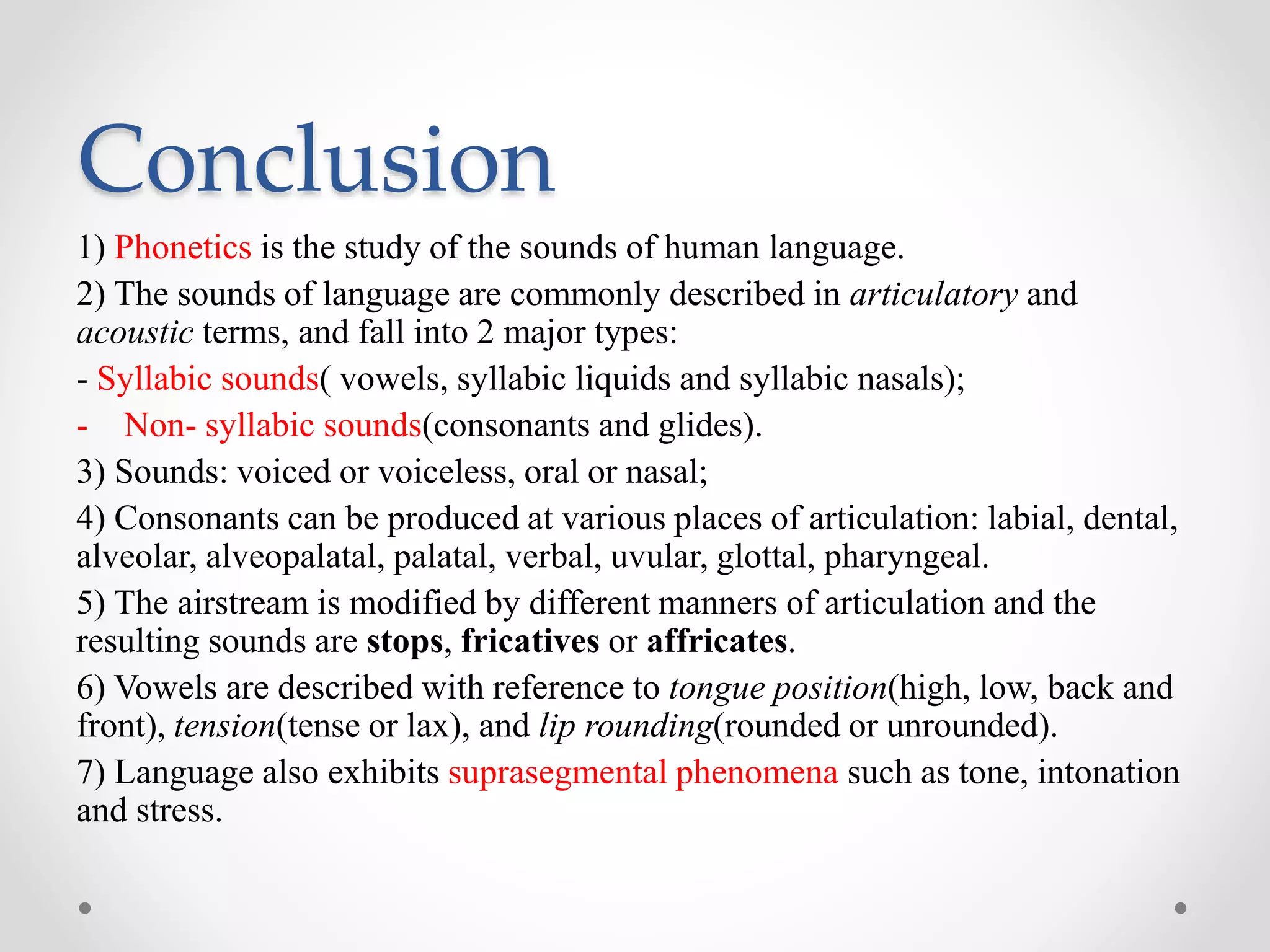The document provides an overview of phonetics, focusing on vowels, diphthongs, suprasegmentals, intonation, and articulatory processes in speech production. It explains the characteristics of various vowel types in British English, the role of tone and intonation in languages, and describes articulatory processes such as assimilation, dissimilation, and deletion. The conclusion emphasizes that phonetics is the study of sound in human language, detailing how sounds are categorized and produced.

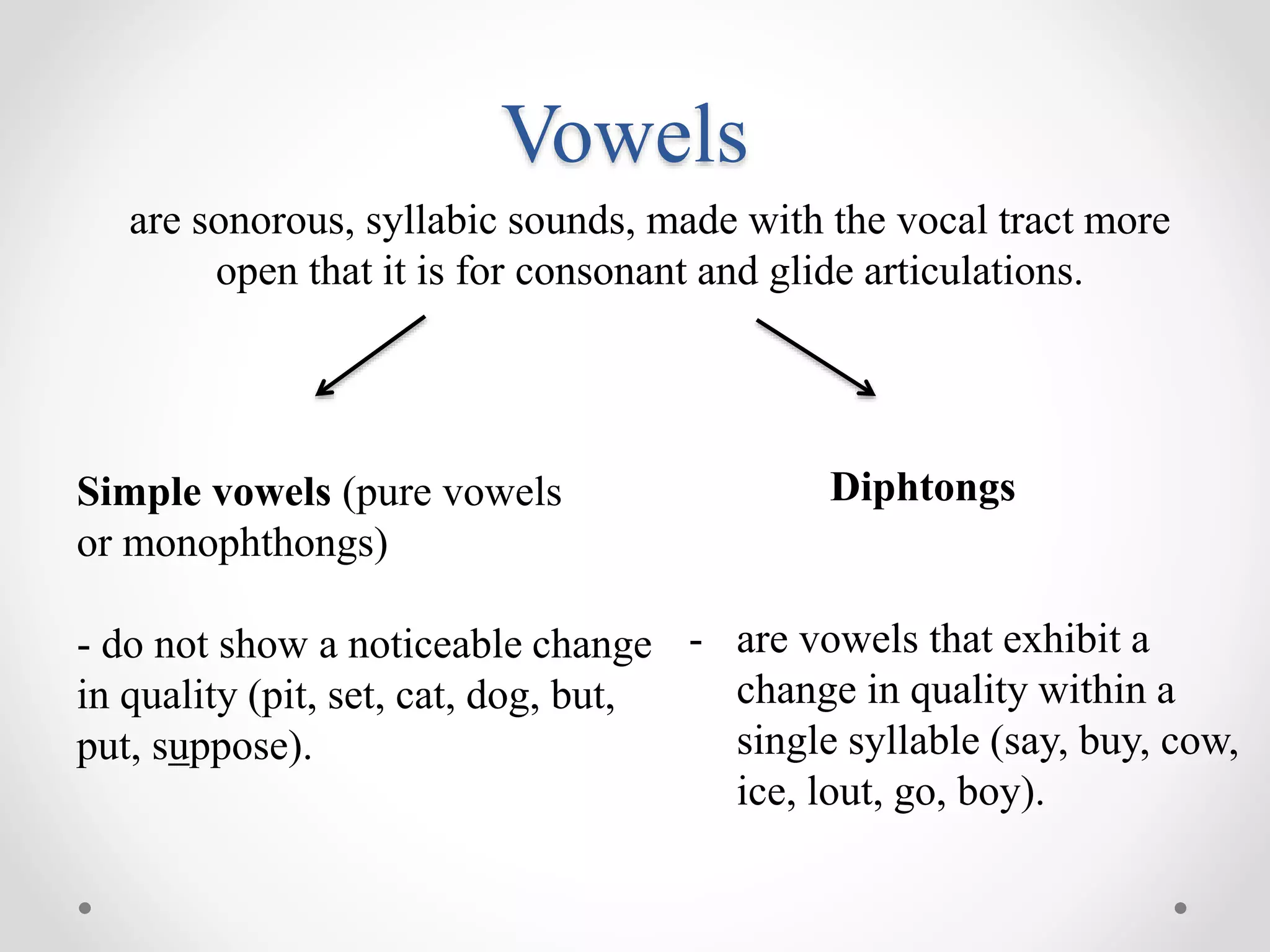
![• Centring diphthongs- the highest point of the tongue moves quickly
towards the center of the mouth, e. g. schwa [ə].
- [iə] as in dear, cheer, clear;
- [eə] as in rare, wear, air;
- [uə] as in boor, sure, dour;
- [ɔə] as in oar, shore, roar.
• Closing diphthongs- the tongue starts in a relatively low position
and ends up in a high position either in the palatal area at the front
of the mouth in the region where the glide [j] is articulated, or at the
back of the mouth in the velar area where the glide [w] is produced.
- [ei] as in way, weight, tail;
- [ai] as in tie, buy, my;
- [ɔi] as in oil, boy, coin;
- [əu] as in no, go, slow;
- [au] as in proud, town, round.
[ɔ:] as in paw, pore, poor [pɔ:]](https://image.slidesharecdn.com/phonetics-170604133801/75/Phonetics-3-2048.jpg)
![Some simple vowels and diphthongs of British (RP) English.
[ei] and [əu]
Say [se:]
Go [go:]](https://image.slidesharecdn.com/phonetics-170604133801/75/Phonetics-4-2048.jpg)
![He, art- the tongue move from a high front to a low back
position.
Part, pat- the tongue moving from the low back, to the to low
front position.
He, who- in addition to a tongue movement between the high
front and high back position, you are also rounding your lips for
the [u:].](https://image.slidesharecdn.com/phonetics-170604133801/75/Phonetics-5-2048.jpg)
![Mid vowels are vowels for which the tongue is neither raised nor
lowered. Schwa [ə], the first and the last vowels of Madonna, the
vowel is central.
Mid- high vowels- [e] the front vowel of set, front and
unrounded.
Mid- low vowels- [ɔ:], the vowel of storm, back and rounded.
Mid- high front unrounded vowel [e] (tail) and mid- low front unrounded vowel [ɛ]
(tell);
Mid- high back rounded vowel [o] (boat) and mid- low back rounded vowel [ɔ]
(bought).](https://image.slidesharecdn.com/phonetics-170604133801/75/Phonetics-6-2048.jpg)



![In English monosyllabic words spoken in isolation do not end in
lax vowels. We find:
See [si:] [si]
Say [sei] BUT NOT [se], [sæ]
Sue [su:] [su]
Saw [sɔ:] [sɒ], [sʌ]
* Schwa, however, frequently appears in unstressed position in
polysyllabic words like sof[ə] and Canad[ə]. It should be pointed
out, that many speakers produce the final vowel in the last two
examples not as [ʌ], but as [ə].](https://image.slidesharecdn.com/phonetics-170604133801/75/Phonetics-10-2048.jpg)



![Pitch:
- All sounds give us a subjective impression of being relatively
higher or lower in pitch.
- It is the auditory property of a sound that enables us to place it
on a scale that ranges from low to high.
- Is especially noticeable in sonorous sounds like vowels, glides,
liquids and nasals.
- Stop and fricative consonants convey different pitches.
- By extending the pronunciation of [s] and then [ʃ], the [s] is
clearly higher pitched.](https://image.slidesharecdn.com/phonetics-170604133801/75/Phonetics-14-2048.jpg)
![Controlled pitch movement
tone intonation
A language is said to have tone or be a tone language, when
differences in word meaning are signaled by differences in
pitch.
Ma [mà]- scold (falling);
Ma [má]- hemp (rising).
Level tones that signal meaning differences are called register
tones: two or three register tones are the norm, though four
have been reported to Mazatec, a language spoken in Mexico.](https://image.slidesharecdn.com/phonetics-170604133801/75/Phonetics-15-2048.jpg)
![In Mende, spoken in West Africa, certain polysyllabic forms show the same
tone on each syllable the diacritic [´] indicates a high tone and the diacritic [`]
indicates a low tone.
In some languages, tones can change pitch within a single syllabic element.
Moving pitches that signal meaning differences are called contour tones. In
Mandarin, both register and contour tones are heard.](https://image.slidesharecdn.com/phonetics-170604133801/75/Phonetics-16-2048.jpg)
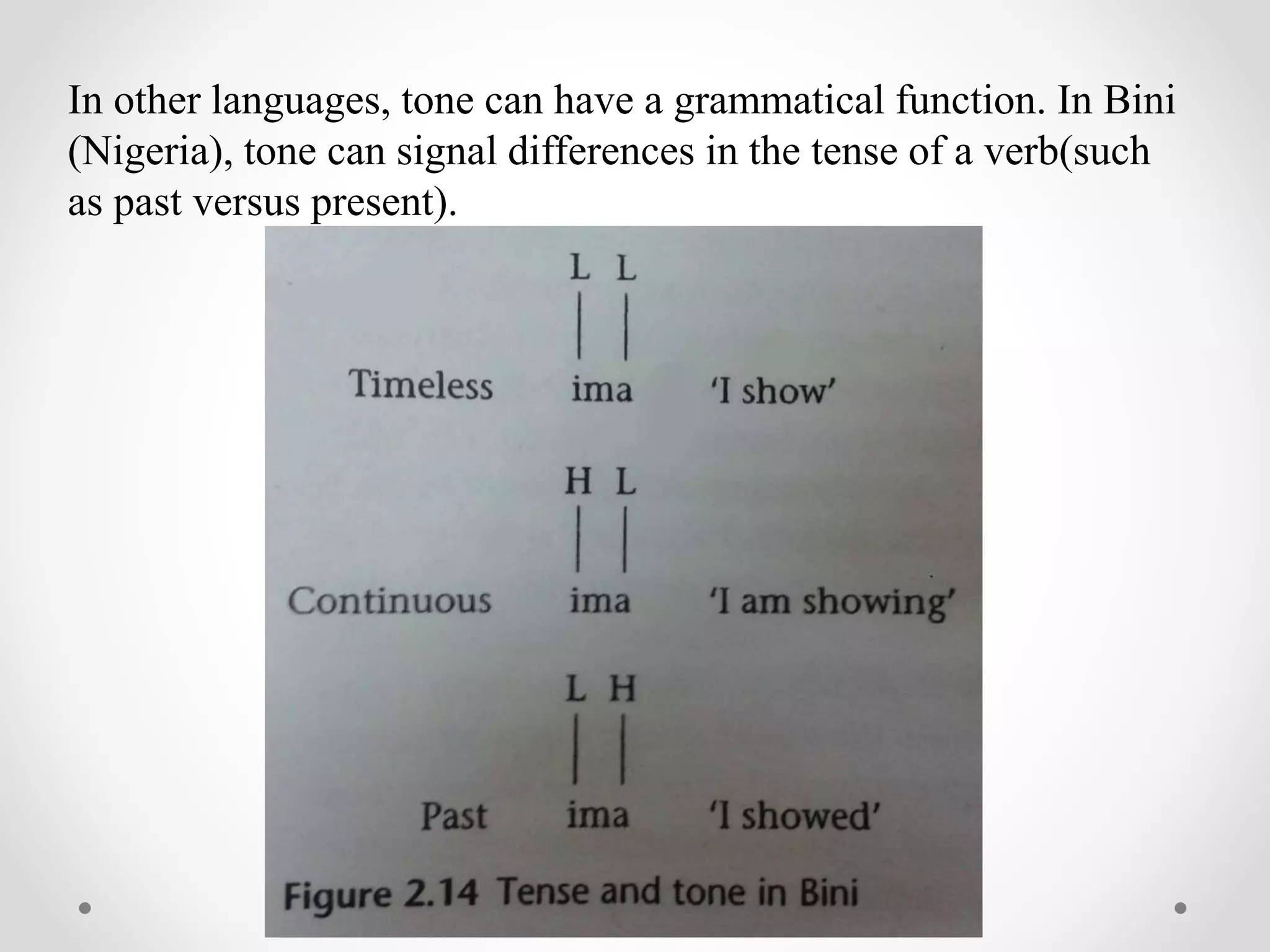
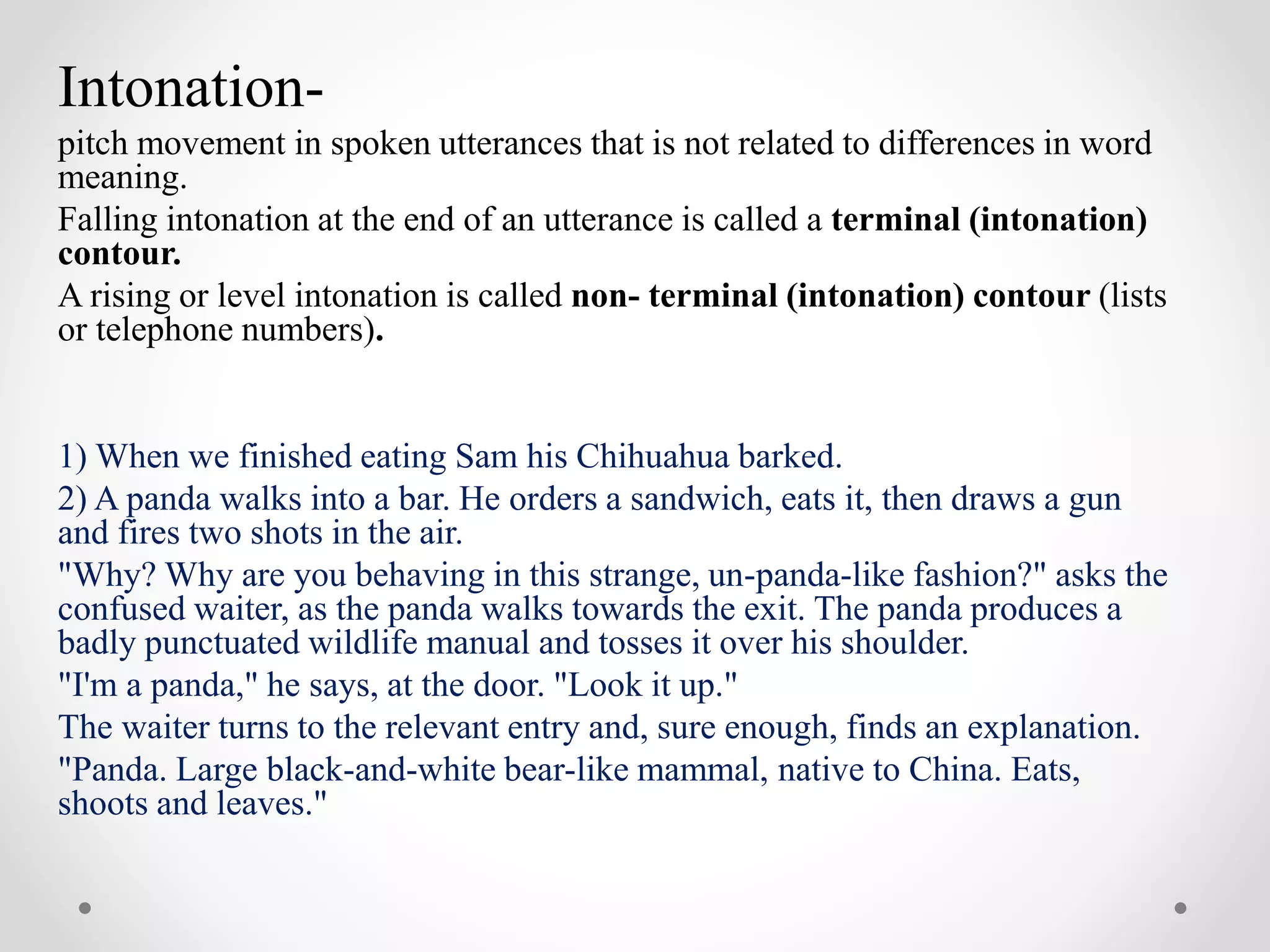
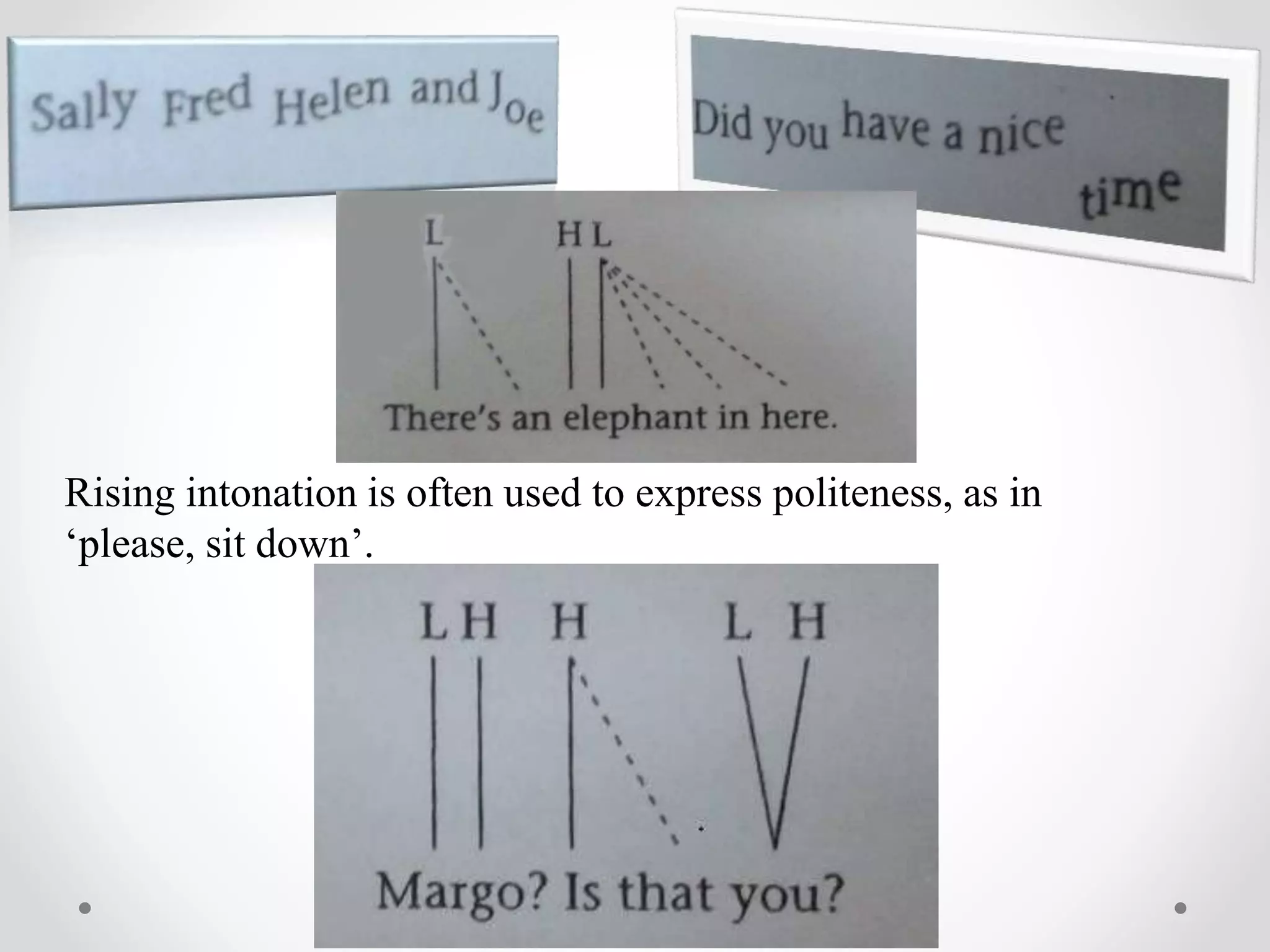

![Length-
is a phenomenon, when the articulation of both vowels and consonants
takes longer relative to that of other vowels and consonants. Length is
indicated with a colon [:].
Stress
English stressed vowels are higher in pitch, longer and louder than
unstressed ones.
North American:
- Acute accent [´], placed over the vowel nucleus in question to mark
the most prominent or primary stress;
- Grave accent [`] to mark the second most prominent or secondary
stress/-es.](https://image.slidesharecdn.com/phonetics-170604133801/75/Phonetics-21-2048.jpg)
![Speech production-
Often results in the articulation of one sound affecting that of
another sound. The phenomenon is a complex one, and many fine
adjustments are carried out very rapidly while speaking:
1) The term coarticulation is used for situations such as this in
which more than one articulator (here the lips and the tongue
tip) is active, e. g. [pl].](https://image.slidesharecdn.com/phonetics-170604133801/75/Phonetics-22-2048.jpg)
![2) Articulatory adjustments that occur during the production of
connected speech are called processes. Processes change the nature of
the individual segment. Ex.: [prejd]- parade.
- It’ s Fred
- Did you say ‘It’ s red’?
- No, I said ‘Fffreeeeeed’.
Inserting vowels inside a group of consonants:
- Stop screaming!
- What? Stop dreaming?
- I said, ‘Stop sc[ə]reaming!’
Two basic reasons for the existence of articulatory processes are: more
efficient articulation(the precise timing and coordination of speech is
relaxed to various degrees) and more distinct output(easier to perceive
than fluent or rapid everyday speech).](https://image.slidesharecdn.com/phonetics-170604133801/75/Phonetics-23-2048.jpg)
![Some common articulatory processes:
1) Assimilation is resulted from the influence of one segment on another.
Always results from a sound becoming more like another nearby sound in
terms of one or more of its phonetic characteristics.
- The type of assimilation, when the preceding segment takes on the nasality
of the following consonant as in [khant] for ‘can’t’, is known as regressive
assimilation, since the nasality moves forward from the nasal consonant
onto the vowel.
- Voicing assimilation. Voiceless liquids and glides occur after voiceless
stops, e.g. please [pli:z], proud [praud] and poor [pjur]. These sounds are
said to be devoiced in this environment.
- Devoicing is a kind of assimilation since the vocal folds are not set in
motion immediately after the release of the voiceless consonant closure.
The opposite is voicing, e.g. the word af [af] ‘off, over’ is pronounced with
a [v] in the words afbellen ‘to cancel’ and afdekken ‘to cover’.
- Flapping is a process in which a dental or alveolar stop articulation changes
to a flap articulation. Flaps are heard in the casual speech pronunciation of
words such as butter, writer, fatter, wader, waiter and even in phrases such
as I bought it [ai barit]. The alveolar flap is always voiced. Flapping is
considered a type of assimilation because it changes a non-continuant
segment(a stop) to a continuant segment(flaps are classified as continuants)
in the environment of other continuants (vowels).](https://image.slidesharecdn.com/phonetics-170604133801/75/Phonetics-24-2048.jpg)
![2) Dissimilation is the opposite of assimilation, results in two
sounds becoming less alike in articulatory or acoustic terms.
Example of dissimilation occurs in words endings with three
consecutive fricatives, such as fifths. Many speakers dissimilate
the final [fθs] sequence to [fts], apparently to break up the
sequence of three fricatives with a stop.](https://image.slidesharecdn.com/phonetics-170604133801/75/Phonetics-25-2048.jpg)
![3) Deletion is a process that removes a segment from certain
phonetic contexts. In English, a schwa [ə] is often deleted when
the next vowel in the word is stressed.](https://image.slidesharecdn.com/phonetics-170604133801/75/Phonetics-26-2048.jpg)
![4) Epenthesis is a process that inserts a syllabic or a non- syllabic
segment within an existing string of segments, e.g. in careful
speech, the words warmth and something are pronounced
[wɔ:mθ] and [sʌmθiŋ]. It is common to insert [p] between m and
th and pronounce the words [wɔ:mpθ] and [sʌmpθiŋ]](https://image.slidesharecdn.com/phonetics-170604133801/75/Phonetics-27-2048.jpg)
![5) Metathesis is a process that reorders a sequence of segments.
Common to hear in childrens’ speech, e.g. spaghetti- pesghetti
[pəskɛti:].
6) Vowel reduction is a process when the articulation of vowels
may move to a more central position when the vowels are
unstressed. The outcome of vowel reduction is a schwa [ə]; this
can be observed in pairs of related words that show different
stress placement such as Canada [kænədə] versus Canadian
[khəneidiən].](https://image.slidesharecdn.com/phonetics-170604133801/75/Phonetics-28-2048.jpg)
![Other vowels and consonants
- Vowels not found in English are in parentheses.
- The tense vowels are long in English. Hence they are usually written ‘:’
after them, e.g. [i:], [u:], etc.
- All vowels can be nasalised.
- Phonetic descriptions are universal- they apply to the sounds of any human
language.](https://image.slidesharecdn.com/phonetics-170604133801/75/Phonetics-29-2048.jpg)
